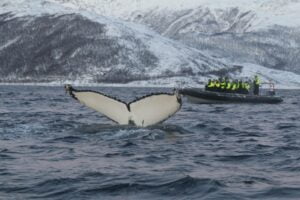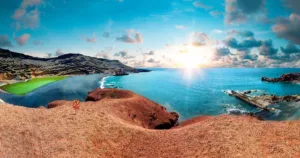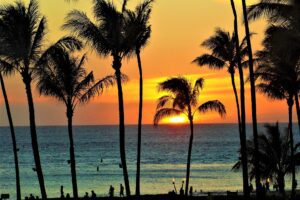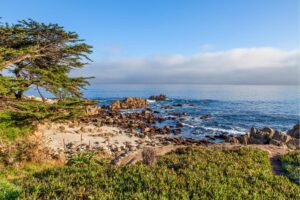Embark on a Majestic Journey: Hawaii Whale Watching Adventures Await!
Welcome to the pristine waters of Hawaii, where each year, these islands become a playground for one of nature’s most awe-inspiring creatures – the humpback whale. If you’re dreaming of that perfect moment when a mighty humpback breaches the ocean’s surface, then aligning your visit with the peak whale-watching months of December through April is key. Experience the thrill of spotting these gentle giants as they complete their annual migration, turning the Hawaiian Islands into a hotspot for whale enthusiasts.
Dive deeper as we explore the seasonal variations across the islands, revealing the best times and locations to catch a glimpse of these majestic mammals. The warm aloha spirit beckons, inviting you to join us on a breathtaking journey of discovery. Grab your binoculars, and let’s set sail for an unforgettable Hawaiian whale watching voyage!
Hawaiian Islands Known for Whale Watching
Are you dreaming of majestic whale encounters? The Hawaiian Islands offer some of the most breathtaking whale watching experiences in the world. Let’s dive into the islands where these gentle giants love to make their appearances.
Oahu: A Gateway to Whale Encounters
Oahu isn’t just about its famous Waikiki Beach or the memorials of Pearl Harbor. It’s also a fantastic spot to start your whale watching journey. With excursions leaving from the leeward coast, you’re likely to see the humpback whales breaching in the deep blue waters. Witnessing these creatures in their natural habitat is truly a spectacular sight.
Maui: A Whale Watching Haven
Maui is often hailed as the epicenter of whale watching in Hawaii, especially in the protected waters of the ‘Au’au Channel between Maui, Lanai, and Molokai. This shallow stretch of water is like a whale’s playground, where humpbacks come to breed and nurse their young. A trip here between December and April can reward you with some of the closest and most frequent whale sightings.
Other Notable Islands for Whale Sighting
- Big Island: The Kohala coast offers incredible opportunities to see humpback whales, with many tours available to take you out into the whale-populated waters.
- Kauai: The serenity of Kauai’s waters can be deceptive, as they’re home to some of the most amazing whale encounters. Be sure to keep your eyes on the water; you might be surprised by a whale or two leaping joyfully.
Each Hawaiian island has its unique charm when it comes to whale watching. Discover these beautiful creatures across the archipelago and create memories that will last a lifetime!
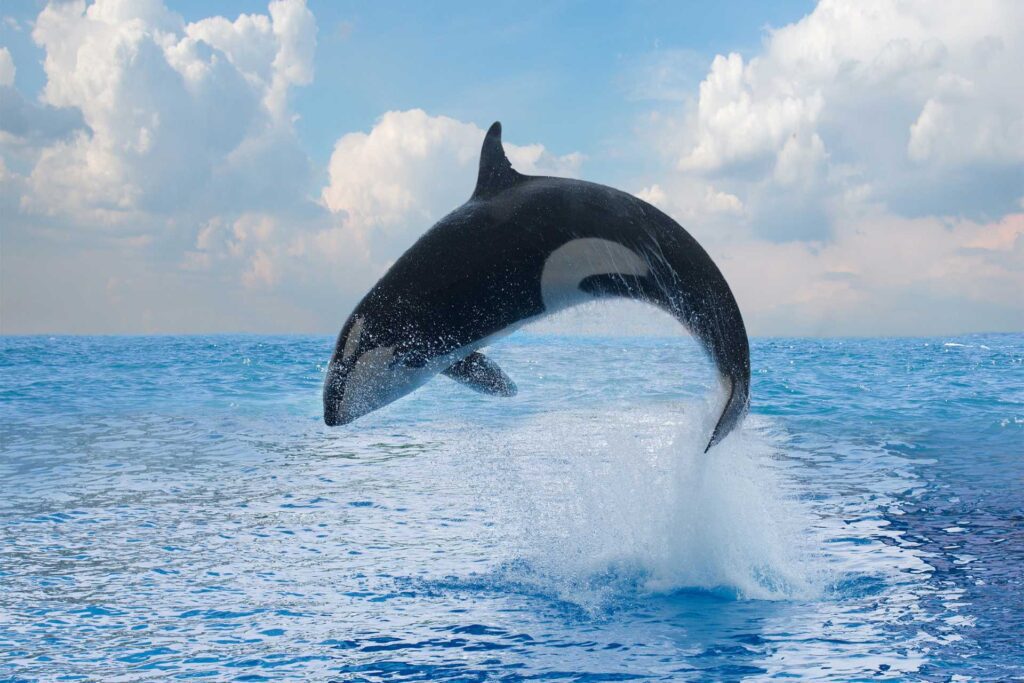

Types of Whales Commonly Seen in Hawaii
When setting off on a Hawaiian whale watching adventure, you’re in for a real treat. Hawai’i’s waters are bustling with an array of magnificent whale species, making every trip an unforgettable experience. Let’s dive into the types of whales that grace these Pacific waters.
Humpback Whales: The Stars of the Show
Humpback whales are undoubtedly the celebrities of Hawaii’s whale watching scene. During the winter months, these majestic creatures journey over 3,000 miles from the chilly Alaskan waters to the warm Hawaiian seas. Here, they partake in an array of activities including breeding, birthing, and nurturing their calves—a spectacle that never ceases to amaze both locals and visitors alike.
Other Whale Species Encountered
- Sperm Whales: Deep-diving hunters known for their impressive size and characteristic large heads, sperm whales are occasional visitors you might spot on your excursion.
- False Killer Whales: Despite their ominous name, these playful cetaceans are often seen swimming in groups and interacting with other sea creatures in a display of their social nature.
- Beaked Whales: Mysterious and less frequently sighted, beaked whales present a special treat to those lucky enough to encounter them as they briefly surface from the ocean’s depths.
- Pilot Whales: Closely resembling their larger cousins, the orcas, pilot whales are known for their strong family bonds and often travel in sizeable pods.
While the humpback whales may steal the show, Hawaii’s waters are a rich tapestry of whale diversity. Each trip out to sea holds the possibility of encounters with these incredible species, making Hawaii a premier whale watching destination.
Eco-friendly Whale Watching Tours
If you’re passionate about preserving the majestic beauty of Hawaii’s marine life while enjoying the awe-inspiring experience of whale watching, eco-friendly tours are the way to go. Witnessing these gentle giants in their natural habitat is a privilege, and it comes with the responsibility of minimizing our environmental footprint. Sustainable tourism not only helps protect the whales and their ocean home but also ensures that future generations will have the same opportunity to cherish these moments as you do today.
Importance of Sustainable Tourism
Whale watching in Hawaii is more than just an activity; it’s an impactful interaction with the ecosystem. Sustainable tourism is key to protecting marine wildlife and the health of our oceans. By choosing eco-friendly tours, you contribute to conservation efforts and support local businesses that are committed to ethical practices. These tours not only follow strict environmental guidelines but also often engage in research and education, making your experience both enjoyable and enlightening.
Recommended Eco-friendly Tour Operators
- Ocean Guardians Adventures: Dedicated to preserving Hawaii’s natural beauty, this operator ensures that all trips are conducted with the utmost care for the whales and their habitat.
- Green Wave Eco Tours: Offering intimate tours with a focus on education, Green Wave takes pride in its zero-waste policy and conservation initiatives.
- Blue Seas Conservation Cruises: With a portion of every ticket sold going toward marine research, Blue Seas is committed to responsible whale watching practices.
Embarking on an eco-friendly whale watching tour is not only about the thrill of sighting these incredible creatures; it’s about making a positive difference. By choosing operators that prioritize the environment, you’re ensuring that whale watching remains a sustainable activity for years to come. So pack your eco-conscious spirit along with your binoculars, and set sail for an unforgettable and responsible adventure!
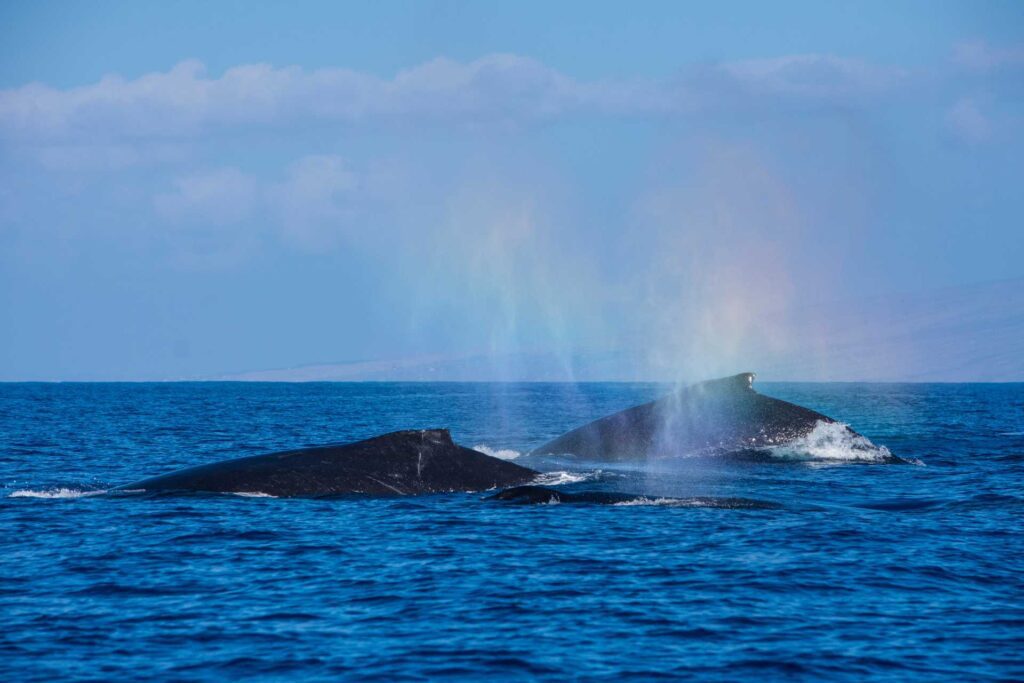

What to Bring on a Whale Watching Trip
Ahoy future whale watchers! Planning your whale watching adventure in the beautiful waters of Hawaii can be thrilling, but knowing what to pack can make or break your experience. Whether you’re a seasoned mariner or a landlubber about to embark on your maiden voyage, here’s a handy guide to help you prepare for an unforgettable day with these majestic creatures.
Essential Items for a Day on the Water
Packing smart is key to a comfortable and enjoyable whale watching trip. You’ll want to bring:
- Weather-appropriate clothing: It can get breezy out on the ocean, so a windbreaker or a jacket is a must, even on sunny days. Layers are your friend!
- Non-slip shoes: Stick to sturdy, closed-toe footwear for safety on the deck. Wet boats can be slippery!
- Sun protection: Sunscreen, sunglasses, and a hat will protect you from the glaring sun.
- Binoculars: To catch a glimpse of those distant breaches and tail slaps.
- Seasickness remedies: If you’re prone to motion sickness, come prepared with medication or natural remedies like ginger chews.
- Snacks and water: Stay hydrated and keep your energy up with light snacks and plenty of fluids.
Gear Checklist for Photographers
For the shutterbugs aiming to capture the perfect fluke shot, don’t forget:
- A good camera: With a zoom lens for those close-up shots from a safe distance.
- Extra batteries/memory cards: You wouldn’t want to miss a spectacular jump because you ran out of power or space!
- Protective gear: Waterproof bags or covers to shield your equipment from saltwater sprays.
- A monopod or stabilizer: To help keep your shots steady on the rolling waves.
Remember, the focus is on the experience, so even if you don’t fancy yourself a photographer, bring a sense of adventure and your keen eyes—you might witness some truly breathtaking moments. Happy whale watching!
Unveiling the Duration and Costs of Hawaii Whale Watching Tours
When it comes to planning your sublime Hawaii whale watching adventure, understanding the duration and costs involved is as crucial as remembering your camera! Let’s dive right into what you can expect for a day among these majestic marine creatures.
Average Length of Tours
The typical whale watching tour in Hawaii lasts anywhere from 2 to 4 hours. This gives you plenty of time to spot whales in their natural habitat and soak in the oceanic splendor of the Hawaiian seascape. Some tour companies also offer extended excursions that can last a full day, perfect for the zealous cetacean enthusiast!
Pricing Breakdown for Various Experiences
The cost of whale watching can vary based on several factors, including the type of tour, the size of the vessel, and the amenities offered onboard. Let’s break it down:
- Standard Group Tours: These are the most budget-friendly option, starting around $30 to $50 per person. You’ll be in the company of other whale watchers, sharing the excitement and the binoculars.
- Mid-Range Tours: For a few more perks and a smaller crowd, prices range from $60 to $100 per person. These tours might include educational commentary from a marine biologist or light refreshments.
- Premium or Private Excursions: If you’re seeking a more personalized experience or a luxury yacht charter, the price can leap to anywhere between $200 to $500+ per person. These high-end tours often boast gourmet meals, superior creature comforts, and custom itineraries.
Remember, while the duration and costs of tours can influence your choice, the experience of witnessing the dance of the whales in Hawaii’s crystal-clear waters is truly invaluable!
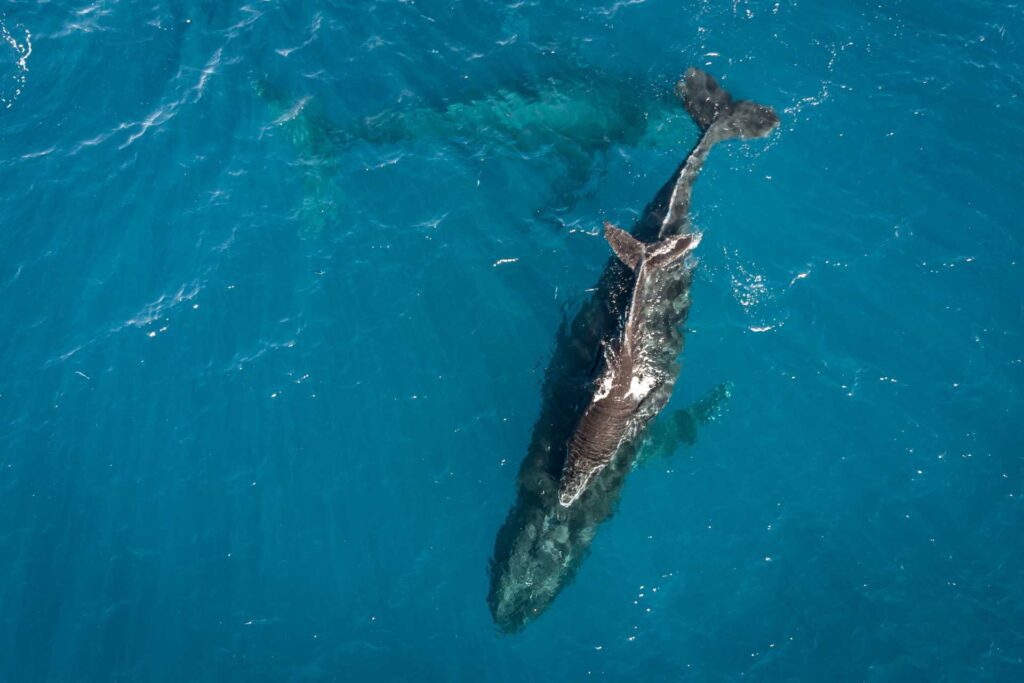

Respect the Giants: Whale Watching Regulations You Should Know
When embarking on the unforgettable adventure of Hawaii whale watching, it’s crucial to be aware of the local regulations designed to protect these magnificent marine creatures. Hawaii takes the safety and preservation of its wildlife seriously, and as such, has strict guidelines in place. Here’s what you need to know to ensure your whale watching experience is both memorable and responsible.
Understanding Local Laws to Protect Wildlife
The Hawaiian Islands are sanctuaries for whales, particularly the North Pacific Humpback Whales that frequent these warm waters to breed and give birth. To safeguard their natural behavior and habitats, several laws have been established. For instance, The Marine Mammal Protection Act and the Endangered Species Act play a pivotal role in conservation efforts, prohibiting the harassment, hunting, capturing, or killing of any marine mammal.
Responsible Practices for Tourists
As a tourist, you’re an active participant in the protection of Hawaii’s whales. Always choose a whale watching operator who follows eco-friendly practices and complies with local regulations. Keep the following responsible practices in mind:
- Maintain a safe distance from the whales. The recommended buffer is at least 100 yards.
- Avoid making loud noises or sudden movements that could startle the whales.
- Never attempt to feed the whales or throw anything into the water.
- Be patient and quiet, minimizing impact on the natural behavior of the whales.
- Use binoculars for a closer view without encroaching on the whales’ space.
By adhering to these guidelines, you’re not just being a law-abiding visitor but also a conscientious guest in the home of these awe-inspiring sea giants. Your respect for their well-being ensures that Hawaii whale watching remains a sustainable and enriching experience for future generations.
What Are Your Chances of Seeing Whales in Hawaii?
Thinking of embarking on a Hawaii whale watching adventure? You’re likely wondering about your chances to actually spot these magnificent mammals. The good news is, Hawaii offers some of the best whale watching opportunities in the world. But let’s set some realistic expectations and talk about the factors that influence whale visibility.
Realistic Expectations for Sightings
While whale watching in Hawaii is a thrilling experience, it’s important to keep in mind that sightings are not guaranteed. However, during peak seasons, many tour operators boast sighting rates of above 90%. This is due to the migration patterns of whales, especially humpback whales, who come to the warm Hawaiian waters to breed and calve. Your chances are excellent, but nature is unpredictable, so come with a hopeful heart and an understanding spirit.
Factors That Affect Whale Visibility
Several factors can influence your ability to spot whales during your outing:
- Weather: Rough seas and strong winds can hinder visibility, so calmer days are preferred for whale watching.
- Time of Day: Early mornings or late afternoons are often the best times to see whales, as the angle of the sun can reduce glare on the water.
- Whale Behavior: Whales can be playful, breach, and slap their fins, or they may be traveling or resting. Active behaviors make them easier to spot.
- Boat Traffic: High volumes of boat traffic might disrupt whales’ natural behaviors and affect your chances of a sighting.
- Experience of the Crew: Experienced tour operators and crews can better interpret whale behavior and find the best spots for watching.
Armed with this knowledge and a bit of luck, your Hawaii whale watching journey is likely to be an unforgettable experience. Remember, every trip out on the ocean offers a unique opportunity to connect with nature and witness the grandeur of whales in their natural habitat.
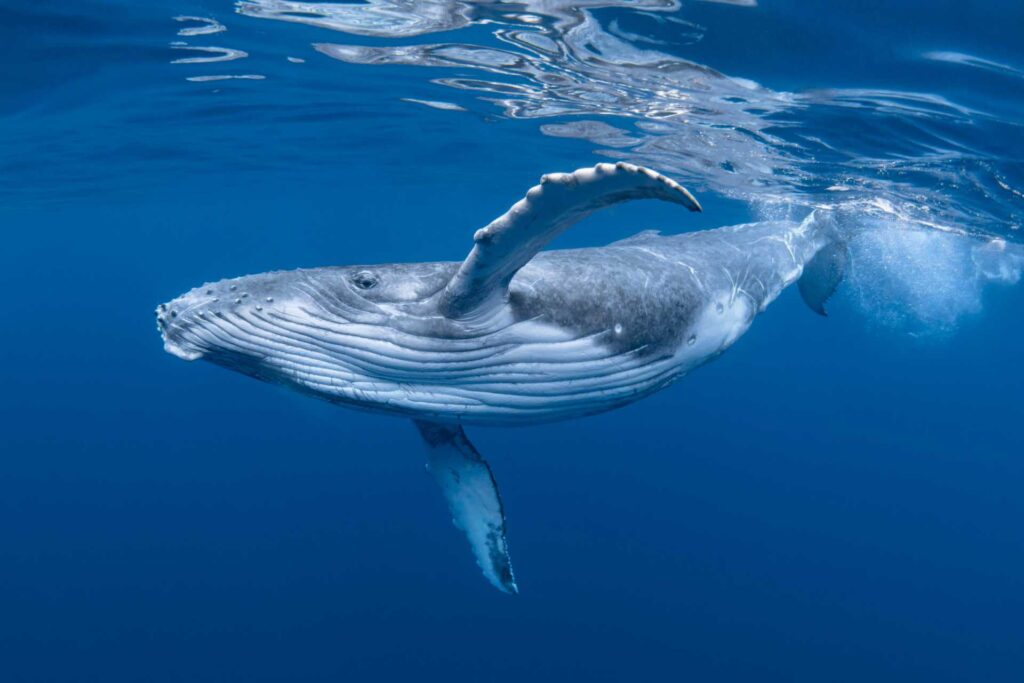

Shore vs. Sea: The Whale Watching Showdown
Ever wondered what the difference is between watching whales from the shore and setting sail on a boat to see these majestic creatures up close? Let’s dive into the pros and cons of both shore-based and boat-based whale watching to see which might float your boat—or fit your flip-flops!
Benefits of Boat Tours
Intimate encounters: Being on a boat gives you the chance to be in the company of whales in their natural habitat. Imagine being so close you can hear every breath the whale takes!
Expertise on board: Most boat tours come with knowledgeable guides who can share fascinating insights about whale behavior and conservation.
Broader reach: Boats can travel to areas where whales are known to congregate, vastly increasing your chances of a thrilling sighting.
Shore-based Watching’s Unique Appeal
Leisure and comfort: Enjoy the leisure of land-based observation with the comforts of your favorite beach chair, natural viewing points, or even beachside restaurants.
Accessibility: Shore-based watching can be more accessible for those who may experience sea sickness or those who prefer not to venture out on a boat.
Cost-effective: Typically, viewing from the shore won’t cost you more than a stroll to the beach, making it a budget-friendly option.
In conclusion, whether you prefer the thrill of a boat ride or the tranquility of shore-side gazing, Hawaii offers spectacular whale watching opportunities for every type of adventurer.
Educational Aspects of Whale Watching for Families and Children
Whale watching in Hawaii isn’t just an awe-inspiring experience – it’s also a fantastic educational opportunity for families and children. As you gaze out over the sparkling waters, witnessing these majestic creatures in their natural habitat, there’s a whole world of learning awaiting young minds. Let’s dive into what makes whale watching so beneficial beyond the breathtaking sights.
Learning Opportunities About Marine Biology and Conservation
The Hawaiian waters serve as a living classroom where children can learn valuable lessons about marine biology and the importance of conservation efforts. Encounter the various species that call these oceans home and understand their behaviors, diets, and roles in the marine ecosystem. The experience brings to life the concept of a delicate oceanic balance, emphasizing why we must protect these incredible animals and their environment.
Family-friendly Tour Options
- Interactive Activities: Many tours offer interactive activities designed for children, such as games and quizzes, to engage with the information being presented.
- Educational Materials: Brochures, informational guides, and sometimes even presentations by marine biologists enhance the learning experience for curious young minds.
- New Perspectives: Engaging with professionals and fellow whale watchers can also spark a child’s interest in marine sciences and environmental stewardship.
By selecting a family-friendly whale watching tour in Hawaii, you’re not only setting the stage for a day of excitement but also planting the seeds of curiosity and reverence for the natural world. There’s nothing quite like the look of wonder on a child’s face when they see a humpback whale breach for the first time – and think of the conversations and questions that will follow!
The Takeaway
For families looking to blend adventure with education, Hawaiian whale watching tours offer an unrivaled experience. Encouraging children to learn about these gentle giants fosters a lifelong appreciation for wildlife and the importance of its conservation. So, pack your binoculars and your sense of wonder – the whales are waiting to teach us all!
Respecting the Giants: Ethical Whale Watching in Hawaii
Imagine you’re visiting the awe-inspiring islands of Hawaii, and you have the chance to witness the majestic humpback whales in their natural habitat. As thrilling as it is, it’s crucial to observe and interact with these gentle giants responsibly. Here’s how you can make your whale watching experience ethical and enjoyable for both you and the whales.
Best Practices for Ethical Wildlife Encounters
- Keep Your Distance: Always maintain a safe and legal distance from the whales. This ensures they aren’t disturbed or stressed by our presence.
- Approach Cautiously: When on a boat, approach whales from the side, moving slowly and predictably to avoid any sudden disruptions.
- No Feeding: Feeding wildlife not only disrupts their natural diet but also encourages them to approach boats in the future, which may pose risks.
- Be Patient: Allow the whales to control the encounter. They may choose to approach you, but it’s always on their terms. Savor the moment, but don’t chase or harass them.
The Role of Tourists in Conservation Efforts
As a visitor to these islands, you play a pivotal role in conservation efforts. Choosing eco-friendly tour operators that respect wildlife regulations is a big step toward supporting sustainable practices in tourism. Additionally, your awareness and advocacy for the protection of marine life can contribute to ongoing conservation campaigns. Remember, responsible tourism helps to ensure that future generations can also enjoy the wonder of whale watching.
At the end of the day, the goal of Hawaii whale watching should be to observe and appreciate the wildlife without leaving a negative impact. By following these guidelines, you’re doing your part to protect the ocean’s giants and their enchanting home. Encounters with wildlife are a privilege; let’s treat them with the respect and care they deserve.
The Remarkable Contribution of Whale Watching to Hawaii’s Economy
Have you ever considered the ripple effect your whale watching adventure has on Hawaii’s local economy? It’s not just a thrilling experience for you; it’s a lifeline for the communities you visit. Let’s dive into how whale-watching turns the tides for Hawaiian economies.
Economic Benefits of Whale Watching Tourism
The allure of witnessing these majestic creatures firsthand has a significant impact on Hawaii. Whale watching is a key driver of tourism, bringing in visitors from around the globe, eager to get a glimpse of the ocean’s gentle giants. These tourists aren’t just spending on the tours themselves; their dollars flow into hotel rooms, restaurants, rental cars, and a plethora of other services that bolster the local economy. The financial wave generated by whale enthusiasts helps ensure that Hawaii’s tourism industry stays buoyant year-round.
Supporting Local Businesses Committed to Sustainability
When you choose a whale watching tour, you’re not just making memories; you’re making a statement. By selecting tours that prioritize eco-friendliness and sustainability, you’re helping to support a market that values and protects Hawaii’s natural wonders. These responsible businesses reinvest in local economies and promote sustainable practices that ensure future generations can also enjoy the magic of whale watching. So, remember, your tour choice has power, and supporting the right businesses creates waves of positive change for Hawaii’s environmental and economic landscape.
Safety Tips for Whale Watching Trips
Embarking on a whale watching adventure is an exhilarating experience that brings you up close with nature’s majestic giants. However, to ensure a safe and enjoyable trip, it’s important to follow some basic safety protocols. Here are essential tips to keep you safe while you’re on the lookout for Hawaii’s ocean behemoths.
Sea Safety Protocols
- Always listen to the crew: The ship’s crew are experienced professionals who understand the nuances of sea travel and wildlife interaction. Heed their instructions at all times.
- Stay aware of your surroundings: Keep a keen eye on the movement of the boat and the ocean. Be mindful of your footing and hold onto railings when moving around.
- Wear a life jacket: In many instances, it’s mandatory to wear a life jacket. Make sure you’re fitted with a life jacket, and that you know how to use it properly.
- Familiarize yourself with the boat: Know where the safety equipment is stored and understand the emergency procedures outlined by the crew.
Preparations for Changing Weather and Water Conditions
- Check the weather: Before departure, review the weather forecast and dress appropriately. Layering is key, as conditions at sea can change rapidly.
- Bring protective gear: Waterproof jackets, hats, and sunscreen are essential, as well as seasickness medication if you’re prone to motion sickness.
- Stay hydrated and eat light: Keep yourself well-hydrated and consume light snacks to maintain your energy levels without upsetting your stomach.
By following these safety tips, your Hawaii whale watching trip will not only be memorable but also secure for you, your family, and the majestic creatures you’ve come to observe. Stay prepared, stay safe, and cherish the awe-inspiring experience.
Private vs Group Whale Watching Tours
Deciding between a private or group whale watching tour can make a significant difference in your Hawaii adventure. Each option offers a unique set of benefits and may cater to different personal preferences. Which is the best fit for your sea excursion?
Pros and Cons of Private and Group Experiences
Private Tours:
- Flexibility: Tailor the trip to your own schedule and preferences.
- Exclusivity: Enjoy the serene ocean with just your companions and the crew.
- Personal Attention: Benefit from one-on-one interaction with the guide, making it a more personalized experience.
- Cost: Generally more expensive than group tours, which can be a con for budget-conscious travelers.
Group Tours:
- Social Interaction: Meet new people and share the thrill as a collective.
- Cost-Effective: More affordable as costs are spread out among participants.
- Shared Experience: Enjoy moments of excitement and awe with fellow enthusiasts.
- Less Flexibility: Operates on a predetermined schedule with little room for change.
How to Decide Which is Right for You
Choosing the perfect whale watching tour depends on what you value most. If you’re looking for a cozy, custom-tailored experience, a private tour is the way to go. On the other hand, if you’re on a budget or enjoy meeting new people, a group tour might be your best option.
Consider the following questions: Do you want your trip to be intimate or are you comfortable with a crowd? Is there a specific whale watching goal you have in mind, like photography or education? How much are you willing to spend?
Compare the different tour offerings, check reviews, and think about the kind of memories you want to create while watching the majestic whales of Hawaii. Ultimately, the choice is yours, and there’s no wrong way to experience the wonder of whale watching in these beautiful islands.
Photographing Whales: Tips and Best Practices
Witnessing whales in their natural habitat is an experience like no other, and capturing those majestic moments on camera can be both exhilarating and challenging. If you’re looking to bring home some stunning visual memories of Hawaii’s gentle giants, here are some tips and best practices to help you get that perfect shot, while respecting the wellbeing of the whales.
Camera Settings and Lenses for Capturing Whale Moments
When photographing whales, the right gear and settings make all the difference:
- Use a Zoom Lens: A lens of at least 200mm is recommended for close-ups while maintaining a respectful distance.
- Fast Shutter Speeds: To freeze the action, especially for breaching whales or fast-moving pods, use a shutter speed of 1/1000th of a second or faster.
- Aperture: A wide aperture (low f-stop number) can help to isolate the whale from the surrounding water, but ensure you have enough depth of field to keep the entire subject in focus.
- Continuous Focus Mode: This helps to keep the moving whale sharp within the frame as you track its movement.
- High Continuous Shooting Mode: Shooting in bursts increases the chances of capturing that split-second action, like a breaching whale or a tail slap.
Ethical Photography Without Disturbing the Whales
Photographing these majestic creatures should not come at the expense of their peace or safety. Here’s how to practice ethical photography:
- Respect the Guidelines: Always follow local whale watching regulations and guidelines. Keep the recommended distance to minimize stress on the whales.
- Patience is Key: Wait for the whales to surface naturally. Don’t attempt to chase or herd whales for a better shot.
- No Flash Photography: Using a flash can disorient and disturb whales, so rely on natural lighting for your photos.
- Minimize Noise: Loud sounds can stress whales. Keep noise to a minimum and let the serene setting work to your advantage.
By following these tips and maintaining an ethical approach to wildlife photography, you’ll enjoy a fulfilling whale watching experience in Hawaii, and come away with beautiful images that have minimal impact on the whales.
Embrace the Majestic Journey of Hawaii Whale Watching
Experiencing the grandeur of whale watching in Hawaii is undeniably a highlight for any wildlife enthusiast. The unique opportunity to witness these magnificent creatures in their natural habitat offers a glimpse into the beauty and complexity of marine life. Whale watching in these islands is not just an exciting adventure; it’s a chance to resonate with nature’s rhythms and understand the crucial role these mammals play in our ocean’s ecosystems.
In the spirit of responsible and respectful wildlife tourism, we urge all aspiring whale watchers to prioritize the well-being of these majestic sea dwellers. By choosing eco-friendly tours and adhering to regulation guidelines, you contribute to the sustainable balance of marine life and help assure that future generations can also enjoy these breathtaking encounters.
- Remember to check the best times of the year for watching whales in Hawaii.
- Pick out the perfect island that offers a memorable whale watching experience.
- Prepare yourself with appropriate gear and knowledge to enhance your experience.
As you prepare to embark on your whale watching adventure, we encourage you to thoughtfully plan your trip with environmentally responsible tour operators. Not only does this ensure a superior experience for you and your loved ones, but it also supports the local economy and safeguards the awe-inspiring wildlife that makes Hawaii so special.
Whether you’re capturing the moment on camera or soaking it all in with your eyes, the magic of Hawaii’s oceans is calling. It’s time to answer the call and book your next grand adventure—responsible, respectful, but above all, remarkable whale watching in the heart of the Pacific.
Embark on the whale watching journey of a lifetime in Hawaii—where the ocean’s song is vibrant, and the leap of a humpback is but a heartbeat away.


